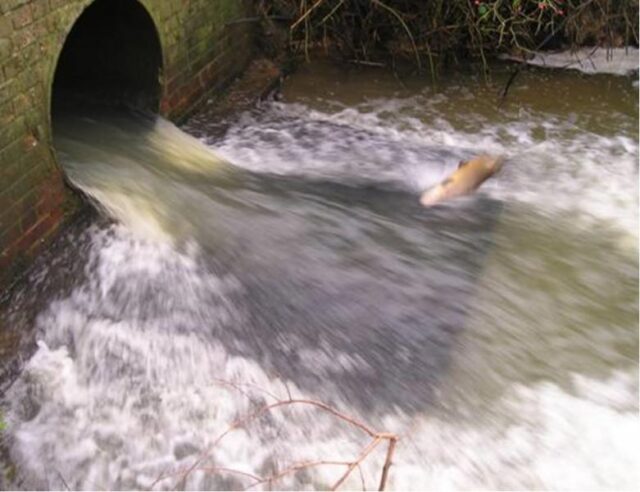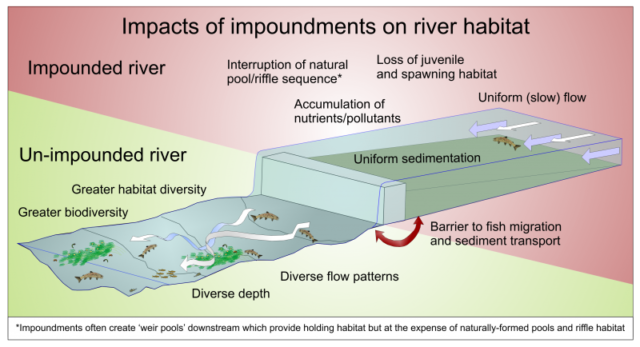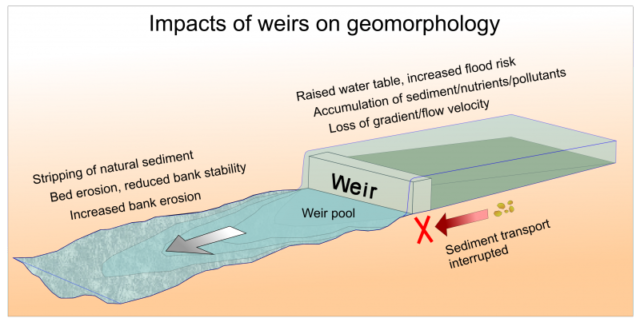This short video from Dam Removal Europe is an excellent explanation of why we remove weirs wherever we can.
The impacts of weirs, dams, culverts and other barriers can be divided, broadly, into two main categories: obstructing fish movement and habitat impacts. Both topics are covered in the information below.
See also this blog post by Paul Gaskell about weirs.
1. Obstructing fish movement
Barriers such as weirs, culverts, hatches and sluices are as great a problem for trout as they are for salmon. It is often assumed that trout do not travel far unless they are sea trout, but resident brown trout also migrate upstream to spawn and disperse to find suitable habitat as they mature and establish new territories.
The video below was filmed by the WTT’s Paul Gaskell and shows brown trout trying to ascend a weir:
As the picture below, shows, obstructions need not be big, just insensitively designed, to pose a problem for migrating fish:

Weirs and culverts cut off access to habitat for all trout, including resident trout that move upstream to access spawning habitat and juvenile trout which must find new territories as they grow and require different types of habitat, or simply become overcrowded.
Barriers result in fragmented and degraded habitat, leading to isolated populations of fish. These isolated populations are vulnerable to problems such as pollution or climate change. A fully connected river habitat is much more resilient as it allows natural recovery and recruitment by migration from trout populations upstream, from side streams or from the sea.
Where practical, removing man made barriers to create a naturally connected river habitat is preferable to installing engineered fish passes which are expensive and require long term maintenance. On many streams, numerous small barriers to migration exist which can be removed or where easements can be created with the involvement angling clubs, rivers trusts and the WTT .
A more detailed discussion on the impacts on trout migration of weirs, dams and culverts and their mitigation can be found in the following WTT documents:
- Obstructions and Wild Brown Trout – WTT information paper
- Obstructions and Wild Brown Trout – WTT information sheet ( a concise summary)
The video below is from Trout Unlimited in the USA, but the messages and actions are very relevant for us in the UK.
2. Habitat impacts
Much attention is paid to the ‘barrier to migration’ effect of weirs, but weirs also have the effect of degrading habitat, often for long stretches both upstream and downstream of the weir. This is because the transportation of riverbed material is interrupted, causing increased levels of silt deposition upstream of the weir and erosion downstream. The habitat upstream of a weir is effectively ‘drowned’ with deeper, slower water and a silty bed. Often this is not ideal habitat for the flora and fauna that should naturally occupy the river. Whilst fish passes can be a vital ‘last resort’ that (when they work and are well maintained) may at least allow some wildlife to pass through this degraded habitat, they cannot do anything to improve the habitat itself. Weir removal restores nature’s ability to heal itself and the preferred option, wherever possible, is to remove or modify weirs rather than build fish passes or easements.


In the video below, the ‘Emriver’ model and real river examples are used to illustrate the impact of weirs.
WTT advice
The WTT can provide guidance on weir removal or modification along with other habitat improvements such as constructing bypass channels. Advice on easements is available in the WTT Information paper Obstructions & Wild Brown Trout.
Advice is also included in the Wild Trout Survival Guide and Upland Rivers Habitat Manual CD, available in the website shop.
Any easement or removal work requires the permission of the relevant authority (NRW, EA, SEPA, Local Authority) and should be accompanied by appropriate instream habitat management and aftercare as the river bed re-profiles after an obstruction is removed/eased.
WTT do’s and don’ts
DON’T assume that weirs are providing good holding habitat for fish. A properly functioning river system with sufficient flows will produce a far greater diversity & abundance of deeper pool areas and vital shallow riffle areas without the negative effects associated with weirs.
DO prioritise removal over fish pass provision where possible. Fish passes should be as a last resort as they do not adequately address the problems of habitat connectivity and degradation.
DO maintain access for trout, even in small un-fished streams; these are often breeding and nursery areas and can produce the majority of juvenile trout in many river systems.
DO continue to improve instream habitat on your river, in spite of the presence of weirs and their overarching impact on habitat connectivity & quality in a river. It is still important that reach scale problems are addressed whilst long term objectives (free fish passage) are addressed. In this way, when they are resolved, the benefits associated with habitat improvements will be maximised.
DO liaise with the relevant regulatory agency personnel who will establish (and potentially influence) the sequence of fish passage solutions. There are many different designs of fish passes and easements suitable for different locations and species and will require specialist input to ensure their effectiveness. In these cases, angling clubs are usually the catalyst & driver for getting the process underway.
DO involve landowners from the outset and educate them on what you are trying to achieve.
DO ‘encourage’ gradual weir removal. On high energy, spate rivers, weirs can erode away over time. Removing a few choice pieces of the upper structure provides the spate flows something to work with to ‘naturally’ remove the weir.
DO encourage the controlled removal of weirs or create notches in weirs which will allow the upstream river bed to re-align itself gradually
Hydropower
Man made changes to river flows can have profound effects on both wild trout populations and the eocsystems that support them. We keep abreast of research and new developments in this area.
For an example of the WTT’s position as at March 2013, see the consultation response below:
WTT Response to EA Hydro Flows Consultation March 2013.
In the meantime, the Angling Trust has produced two papers outlining their position statement on hydropower developments and a guide to objecting to their development. For further information, click on the titles below:
Angling Trust position statement on hydropower
Angling Trust guide to objecting to hydropower developments
The views expressed in these publications are not necessarily those of the WTT.
Environment Agency (England) guidance for run of river hydropower development, issued in February 2016.
The views expressed in these publications are not necessarily those of the WTT.
